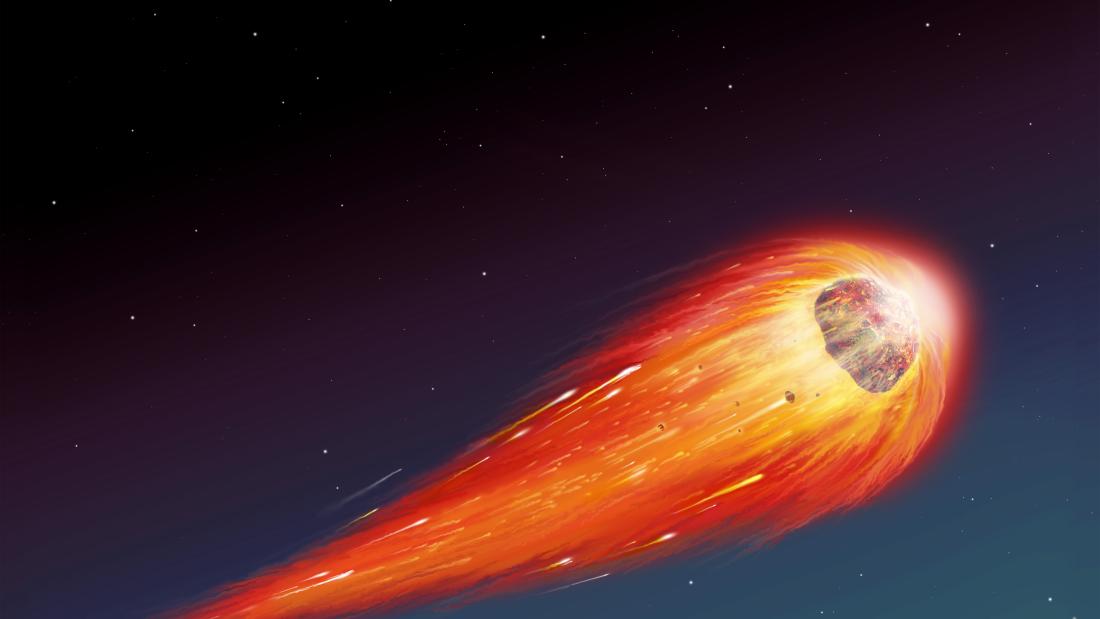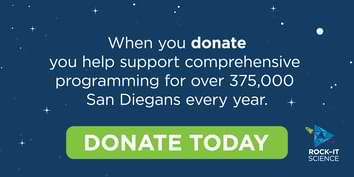
The REUBEN H. FLEET SCIENCE CENTER To Debut GREAT BALLS OF FIRE! Comets, Asteroids, Meteors Exhibition In Conjunction With Cosmic Collisions—A Spectacular Digital Space Show; Both Open Saturday, January 19, 2013!
FOR IMMEDIATE RELEASE, PLEASE:
Media Contact: Susan Chicoine, PR Manager
619-685-5743 / 619-325-9416c schicoine@rhfleet.org
San Diego, CA; December 13 2012—The Reuben H. Fleet Science Center presents Great Balls of Fire! Comets, Asteroids, Meteors, an interactive exhibition making its West Coast debut, in conjunction with the spectacular immersive digital theater experience, Cosmic Collisions. Both will open at the Fleet on January 19, 2013. See full releases below.
~~~~~~~~~~~~~~~~~~~~~~~~~~~~~~~~~~~~~~~~~~~~~~~~~~~~~~~~~~~~~~~~~~~~~~~~~~~~~~~~~~~
A Smashing New Exhibition Makes Its West Coast Debut in January!
GREAT BALLS OF FIRE! Comets, Asteroids, Meteors
Opens Saturday, January 19, at the REUBEN H. FLEET SCIENCE CENTER!
San Diego, CA; December 13 2012—The new Great Balls of Fire! Comets, Asteroids, Meteors exhibition will make its West Coast debut at the Reuben H. Fleet Science Center on January 19, 2013, and remain through April 28, 2013. The threat of a catastrophic impact from an asteroid or comet is a staple of popular culture. If there was a dinosaur-killer in Earth’s past, will humankind suffer the same fate? What are the chances and how do we assess the risks? For that matter, what are asteroids, comets, and meteorites, and where do they come from?
Great Balls of Fire! Comets, Asteroids, Meteors explores recent discoveries and cutting-edge science relating to these incredible objects. Have you ever wondered about the origins of comets, asteroids and meteors? Or what they can tell us about Earth? Come to the Reuben H. Fleet Science Center to explore these mysterious space rocks through hands-on activities, computer-based interactives, meteorite specimens, scale models and an immersive audio-visual experience called Asteroid Encounter.
The exhibition is divided into four areas: Origins, Asteroids, Comets and Impacts. It includes a variety of interactive, multimedia experiences. Visitors of all ages can take on the role of explorers, participate in real-world amateur astronomy activities and make comparisons between the risks of asteroid or comet impacts and more familiar natural disasters such as tsunamis, tornados, earthquakes and volcanic eruptions. It also relates the stories of individual scientists whose work has furthered the study of asteroids and comets.
While asteroids and comets are popular subjects for movies like Armageddon and Deep Impact, they are playing their own starring roles in NASA research, and ongoing discoveries are a highlight of the exhibition. In 2001, NASA’s NEAR Shoemaker spacecraft dramatically landed on the asteroid Eros. In 2005, NASA’s Deep Impact probe collided with Tempel 1, exploring beneath the comet’s surface. In 2007, NASA launched the Dawn spacecraft to the Main Asteroid Belt, orbiting the asteroid Vesta. Both NASA and numerous amateur astronomers will be closely monitoring the progress of two possible “Great Comets” in 2013, ISON and PANSTARRS.
Great Balls of Fire! Comets, Asteroids, Meteors includes exhibits, an education program, an outreach program to engage amateur astronomers, a public website (http://www.killerasteroids.org/) and a program website (http://www.greatballsoffireexhibit.org/). Developed by The Space Science Institute’s National Center for Interactive Learning, with funding from the National Science Foundation and NASA, this new exhibition debuted on May 28, 2012. The exhibition has only traveled to the Science Museum of Virginia, Strategic Air & Space Museum in Nebraska, and Catawba Science Center in North Carolina. The Reuben H. Fleet Science Center is delighted to host its West Coast landing!
Great Balls of Fire! Comets, Asteroids, Meteors opens January 19, 2013, and remains through April 28, 2013. The Reuben H. Fleet Science Center is located at 1875 El Prado, San Diego, CA 92101. Gallery admission, which includes access to all eight exhibit galleries: Adults $11.75; Children/Seniors $9.75. The Fleet’s hours are Monday–Thursday 10AM–5PM, Friday & Saturday 10AM–7PM, and Sunday 10AM–6PM. For more information, call (619) 238-1233 or visit our website at www.rhfleet.org/site/exhibition/upcomingexhibits.html.
~~~~~~~~~~~~~~~~~~~~~~~~~~~~~~~~~~~~~~~~~~~~~~~~~~~~~~~~~~~~~~~~~~~~~~~~~~~~~~~~~~~
Cosmic Collisions—A Spectacular New Digital Space Show—
Crashes Into the Reuben H. Fleet Science Center’s Eugene Heikoff and Marilyn Jacobs Heikoff Dome Theater on Saturday, January 19!
Narrated by Academy Award®-Winner Robert Redford and Featuring
Data and Simulations by NASA, Museum Astrophysicists and Scientists Around the World
Spectacular Images of Planetary Impacts and Celestial Smash-Ups!
San Diego CA–December 13, 2012—A spectacular immersive digital theater experience, Cosmic Collisions, narrated by award-winning actor, director and producer Robert Redford, crashes into the Reuben H. Fleet Science Center’s Eugene Heikoff and Marilyn Jacobs Heikoff Dome Theater on Saturday, January 19! Featuring stunning images from space and breathtaking visualizations based on cutting-edge scientific data, the dazzling new Cosmic Collisions reveals the unimaginable, explosive encounters that shaped our solar system, changed the course of life on Earth and continue to transform our galaxy and dynamic universe.
From subatomic particles to the largest galaxies, cosmic collisions are a universal force of nature. Creative and also destructive, dynamic and dazzling, collisions have resulted in many things we take for granted—the luminescent Moon, the Sun’s warmth and light, our changing seasons and waves washing up on a sandy shore. They’ve ended the age of dinosaurs and changed the very map of the cosmos, reforming galaxies and giving birth to new stars and new worlds. Cosmic Collisions provides an unprecedented and extraordinary view of these events—both catastrophic and constructive—that have shaped our world and our universe.
Cosmic Collisions launches visitors on a thrilling trip through space and time—well beyond the calm face of the night sky—to explore cosmic collisions, hypersonic impacts that drive the dynamic and continuing evolution of the universe. Groundbreaking scientific simulations and visualizations based on cutting-edge research developed by American Museum of Natural History astrophysicists, scientists at the National Aeronautics and Space Administration (NASA) and other international colleagues explore the full range of space collisions, past, present and future.
Viewers will witness the violent face of our Sun, imaged by NASA satellites, that produces enormous ejections of material from our star toward our planet. The resulting subatomic clashes, as streams of charged particles from the Sun strike the Earth's magnetic field, produce the eerie glow of the aurora borealis and the aurora australis. Cosmic Collisions also shows the creation of our Moon some five billion years ago when a wandering planetoid struck Earth; the violent meeting of two stars at the edge of the galaxy; and the future collision of our Milky Way galaxy with our closest neighbor, the Andromeda spiral galaxy, a cosmic crash that will produce a new giant elliptical galaxy billions of years from now.
Audiences will feel the ground shake beneath them as they experience a thrilling recreation of the meteorite impact that hastened the end of the age of dinosaurs 65 million years ago and cleared the way for mammals like us to thrive. Another dramatic sequence highlights a frightening future scenario where humanity desperately attempts to divert the path of an oncoming "doomsday" asteroid headed on a collision course with Earth.
An engrossing, immersive digital theater experience created by the American Museum of Natural History visualization and production experts with the cooperation of NASA and more than 25 leading scientists from the United States and abroad, Cosmic Collisions launches visitors on an awe-inspiring trip through space and time. The show focuses on the full range of collisions, from catastrophic planetary impacts and the merging of massive galaxies to the continual explosions occurring in the center of the Sun and the incessant barrage of small ionized particles in the solar wind ricocheting off Earth’s magnetic field creating other-worldly conditions called “space weather.” Cosmic Collisions brings together the visionary genius of scientists and the insatiable curiosity of explorers to shed light on the universe’s most complex and mysterious processes. Take the journey into deep space to learn and be enriched by this unique experience!
Cosmic Collisions was developed by the American Museum of Natural History, New York, in collaboration with the Denver Museum of Nature & Science; GOTO, Inc., Tokyo, Japan; and the Shanghai Science and Technology Museum, China. Cosmic Collisions was created by the American Museum of Natural History with the major support and partnership of the Heliophysics Division of NASA’s Science Mission Directorate and was made possible with the generous support of CIT.
Cosmic Collisions was written by Stephanie Abrams, award-winning writer and director of documentaries for PBS and USA Networks, and Emmy Award-winner Louise A. Gikow, with music by renowned Brazilian pianist and composer Marcelo Zarvos and award-winning composer Robert Miller.
Cosmic Collisions opens Saturday, January 19, 2013, and will run in an open-ended engagement. The Reuben H. Fleet Science Center Heikoff Dome Theater is located at 1875 El Prado, San Diego, CA 92101. Giant Dome Screen Theater admission (1 film + access to all exhibit galleries): Adults $15.75; Children $12.75; Seniors $12.75. The Fleet’s normal hours are Monday–Thursday 10AM–5PM, Friday & Saturday: 10AM– 7PM, and Sunday: 10AM–6PM. For information on tickets and show times, call (619) 238-1233 or visit our website at http://www.rhfleet.org/shows.
# # #
About The Space Science Institute
The Space Science Institute’s National Center for Interactive Learning is a nonprofit organization that carries out world-class research in space and Earth science, together with innovative science education programs that inspire and deepen the public’s understanding of planet Earth and its place in the Universe. The institute's integrated research and education programs span planetary science, space physics, astrophysics, astrobiology, and Earth science.
# # #
DOWNLOADS FOR MEDIA:
Press releases, backgrounders and photo caption sheets: http://www.rhfleet.org/press-room
High-resolution photographs: http://www.rhfleet.org/press-room/images.
B-roll of Giant Dome Theater Shows & production footage of exhibits and galleries: Fleet Media DropBox: https://www.dropbox.com/; sign in; email: reubenfleet@gmail.com; password: pr1973media; "RHF Public Relations."
# # #

